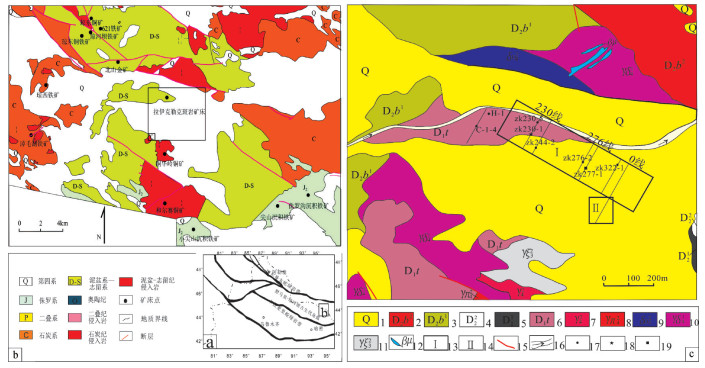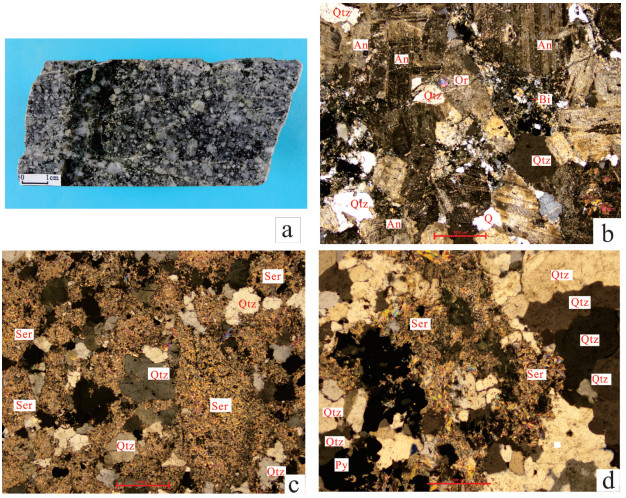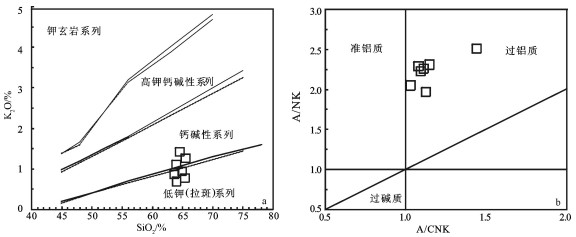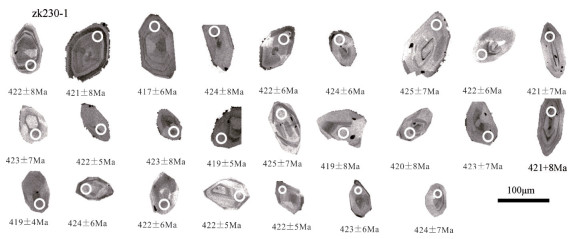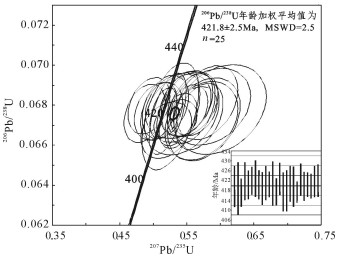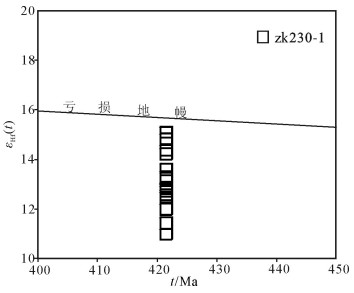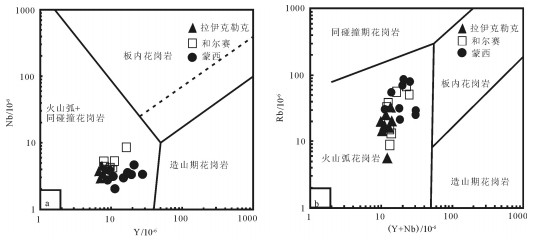Rock-forming and ore-forming ages and geochemistry of the Layikeleke porphyry Cu(Mo) deposit in East Junggar of Xinjiang and their geological significance
-
摘要:
拉伊克勒克矿床是在第四系覆盖区新发现的隐伏斑岩铜(钼)矿床。采用LA-ICP-MS技术,对赋矿岩体英云闪长岩中的锆石和矿石中的辉钼矿分别进行锆石U-Pb同位素、Re-Os同位素和锆石Hf同位素测定及相应的研究。测得锆石U-Pb年龄为421.8±2.5Ma,辉钼矿Re-Os模式年龄为409.1±2.6Ma,表明拉伊克勒克斑岩铜(钼)矿床形成于晚志留世—早泥盆世,与琼河坝地区主要斑岩矿床大规模成矿时间一致。英云闪长岩属过铝质-钙碱性系列花岗岩类,岩体具有较高的铝钙含量,K2O/Na2O值普遍偏低,介于0.16~0.29之间;稀土元素配分曲线呈现右倾特征,稀土元素总量较低,轻稀土元素相对富集,负Eu异常不明显。在微量元素原始地幔标准化蛛网图上,高场强元素Th、Nb、Ta、P、Ti等相对亏损,大离子亲石元素Rb、Ba、U、K、Sr等相对富集。同时岩体具有高的正εHf(t)值(10.98~15.01)和年轻的模式年龄(451~708Ma),暗示英云闪长岩体是大陆边缘弧环境下大洋板片熔融的产物,对进一步明确琼河坝地区斑岩型矿床的成矿环境和找矿方向具有重要意义。
-
关键词:
- LA-ICP-MS锆石U-Pb年龄 /
- 辉钼矿Re-Os年龄 /
- 地球化学 /
- Hf同位素 /
- 斑岩铜矿床 /
- 英云闪长岩 /
- 拉伊克勒克
Abstract:The Layikeleke deposit is a concealed porphyry deposit newly discovered by comprehensive geoprehensive exploration in Quaternary coverage area. In this paper, U-Pb dating of LA-ICP-MS zircon and dating of Re-Os isotope and Hf isotopes were conducted to investigate the petrology, isotope geochemistry and the age of mineralized tonalities. U-Pb dating of LA-ICP-MS zircon was conducted to investigate the age of the sample, which is 421.8±2.5Ma, and the Re-Os weighted mean age for five molybde-nite samples is 409.1±2.6Ma, suggesting that, from the Late Silurian to the Early Devonian, the Layikeleke porphyry copper (molyb-denum) deposit was formed here, similar to things of the porphyry in Qiongheba area. The tonalities are of peraluminous and calc-al-kaline series with high Al2O3, CaO and low K2O/Na2O ratios. The pluton has low total REE content with relative enrichment of LREE and obscure Eu negative anomaly. The primitive mantle normalized trace element patterns are characterized by the depletion of the HFSE (Th, Nb, Ta, P, Ti) and enrichment of the LILE (Rb, Ba, U, K, Sr). The testing results of Hf isotope show that tonalitie plutons have high and positive εHf(t) and younger model age, indicating that they were formed in a continental margin arc setting and were related to partial melting of subducted oceanic crust. The results obtained by the authors have important significance for deepen-ing the understanding of magmatic hydrothermal metallogenesis in this area.
-
Keywords:
- LA-ICP-MS zircon U-Pb age /
- molybdenite Re-Os age /
- geochemistry /
- Hf isotope /
- porphyry copper deposit /
- tonalite /
- Layikeleke
-
中亚造山带是世界上最大的古生代增生带和最大的显生宙大陆地壳生长带[1-7], 是一个持续俯冲增生造山带[8-10]。北山造山带作为中亚造山带的重要组成部分(图 1-a),是研究和支撑中亚造山带古生代构造格局的关键地区[12]。
![]() 图 1 北山造山带蛇绿岩时空分布(a)和中亚造山带构造简图(b)(据参考文献[11]修改)Figure 1. Temporal and spatial distribution of ophiolites in the Beishan orogenic belt(a) and structural sketch map of the Central Asian orogenic belt(b)
图 1 北山造山带蛇绿岩时空分布(a)和中亚造山带构造简图(b)(据参考文献[11]修改)Figure 1. Temporal and spatial distribution of ophiolites in the Beishan orogenic belt(a) and structural sketch map of the Central Asian orogenic belt(b)内蒙古北山地区位于中亚造山带南缘,西邻东天山,东接阿拉善,其大地构造位置较复杂[13-16]。经历了多阶段的俯冲拼贴过程,形成了从南向北依次出露的柳园-账房山、洗肠井-白云山-牛圈子-红柳河、小黄山-芨芨台子、红石山-百合山等多条蛇绿混杂岩带(图 1-b),前人对不同的蛇绿岩进行了研究,获得了丰富的资料[17-24]。近年的研究资料表明,北山造山带中部的洗肠井-白云山-牛圈子-红柳河蛇绿岩最早形成于寒武纪[13, 20, 25],奥陶纪向北强烈俯冲[10]。对于早泥盆世的构造属性,存在柳园蛇绿岩向北俯冲[26-28]、同碰撞或弧陆拼贴[29]、造山后伸展[30]等多种认识,泥盆纪岩浆岩成为研究古生代洋陆转化的重要载体之一。然而,前人的研究集中在花岗岩类,对火山岩的研究很少。李向民等[31]及Guo等[26]报道了在牛圈子地区的志留纪—泥盆纪三个井组火山岩,该火山岩地层的东西向延伸、区域对比亟需进一步研究。
鉴于此,本文以最新的1:5万填图资料及测试数据为基础,通过岩石学、岩石地球化学、锆石Lu-Hf同位素等特征的综合分析,对白云山南侧三个井组火山岩的时代归属进行重新厘定,研究其岩石成因及形成的大地构造环境,为探讨白云山洋盆的闭合时限提供重要的依据。
1. 区域地质
白云山东距额济纳旗约250 km,东临月牙山-洗肠井蛇绿构造混杂岩带,西部为牛圈子蛇绿岩带(图 1)。白云山蛇绿岩带呈北西西向带状展布,东西长约26 km,南北宽2~4.5 km。下部主要出露橄榄岩、辉橄岩、二辉橄榄岩等超基性杂岩,普遍蛇纹石化,构造混杂岩带强糜棱岩化,辉长岩和斜长花岗岩呈岩株状侵出地表;上部为红褐色-紫红色含放射虫硅质岩,构造作用强烈,多呈岩块分布于蛇绿构造混杂岩带中,表现出远洋沉积的特征并被后期辉绿岩脉侵入。蛇绿构造混杂岩带北部为晚奥陶世白云山组弧前盆地沉积建造及中志留世石英闪长岩,被认为是哈萨克斯坦板块与塔里木板块之间大洋俯冲的产物[13]。混杂岩带南部出露二叠纪、泥盆纪侵入体,地层主要为被动陆缘沉积的晚奥陶世锡林柯博组,主要岩性为灰绿色变质长石岩屑砂岩、灰绿色变质长石石英砂岩、灰褐色白云岩等,被敦煌地块中新元古界碳酸盐岩沉积盖层逆冲掩覆。研究区三个井组是从前人认为的横峦山群中新识别而来的,与北侧的锡林柯博组呈断层接触,岩石组合主要为一套凝灰质长石岩屑砂岩、凝灰质粉砂岩、硅质粘土岩夹基性-中基性火山岩。火山岩主要由玄武岩、玄武安山岩、流纹质凝灰岩等组成,玄武岩以层状构造为主,部分发育枕状构造及气孔杏仁状构造(图 2-a)。
![]() 图 2 月牙山幅地质简图(a)和三个井组PM06实测剖面(b)①a图:1—中、新元古界;2—寒武纪—奥陶纪西双鹰山组;3—晚奥陶世锡林克博组;4—晚奥陶世白云山组;5—早泥盆世三个井组二段;6—晚泥盆世墩墩山组;7—早白垩世赤金堡组;8—新近系;9—第四系;10—白云岩透镜体;11—蛇绿岩带;12—超基性岩块;13—花岗闪长岩;14—石英闪长岩脉;15—闪长岩脉;16—断层;17—PM06剖面位置;b图:1—安山质晶屑凝灰岩;2—长石岩屑砂岩;3—凝灰质长石岩屑砂岩;4—杏仁状安山岩;5—玄武岩;6—流纹斑岩;7—闪长岩;8—硅质白云岩;9—结晶灰岩;10—安山岩;11—断层破碎带;12—不整合界线;13—产状;14—采样位置Figure 2. Geological map of Yueyashan Sheet(a)and measured profile PM06 of Sangejing Formation(b)
图 2 月牙山幅地质简图(a)和三个井组PM06实测剖面(b)①a图:1—中、新元古界;2—寒武纪—奥陶纪西双鹰山组;3—晚奥陶世锡林克博组;4—晚奥陶世白云山组;5—早泥盆世三个井组二段;6—晚泥盆世墩墩山组;7—早白垩世赤金堡组;8—新近系;9—第四系;10—白云岩透镜体;11—蛇绿岩带;12—超基性岩块;13—花岗闪长岩;14—石英闪长岩脉;15—闪长岩脉;16—断层;17—PM06剖面位置;b图:1—安山质晶屑凝灰岩;2—长石岩屑砂岩;3—凝灰质长石岩屑砂岩;4—杏仁状安山岩;5—玄武岩;6—流纹斑岩;7—闪长岩;8—硅质白云岩;9—结晶灰岩;10—安山岩;11—断层破碎带;12—不整合界线;13—产状;14—采样位置Figure 2. Geological map of Yueyashan Sheet(a)and measured profile PM06 of Sangejing Formation(b)2. 岩石学特征
枕状玄武岩:中等风化程度,风化面呈灰色-灰绿色,新鲜面呈深灰色-灰色,局部枕状构造明显,表面常见小气孔。主要矿物组成为斜长石+辉石(75%),暗色矿物(25%),岩石由斑晶、基质组成。斑晶主要由矿物假象组成,粒径约1 mm,零星分布,后期被帘石交代呈假象产出,含量约为2%。基质由斜长石、暗色矿物组成,粒径小于0.2 m。斜长石呈板条状,长轴多显定向排列,略显残余间粒结构,后期具帘石化、粘土化、褐铁矿化、碳酸盐化、次闪石化;暗色矿物后期多具帘石化、褐铁矿化、次闪石化呈假象产出。岩内可见被硅质、褐铁矿、少量碳酸盐矿物充填的微裂纹。
气孔-杏仁状玄武岩:风化作用较强,风化面和新鲜面都为深灰色,岩内未见斑晶。岩石由斜长石、辉石和暗色矿物组成,斜长石含量约为65%,辉石含量约20%,暗色矿物约为15%。斜长石呈半自形板状、板条状,粒径为0.1~1 mm,长轴定向排列,显交织结构,后期具粘土化、绢云母化、碳酸盐化、褐铁矿化。暗色矿物后期具帘石化、褐铁矿化、碳酸盐化、绿泥石化,呈假象产出,杂乱分布于斜长石间。岩内多见被碳酸盐、硅质、帘石充填的杏仁体,呈云朵状、不规则状,大小为0.5~10 mm,长轴多显定向排列,岩内另见被碳酸盐矿物充填的裂隙。杏仁体占岩石体积的10%~15%。
3. 实验方法
用于岩石地球化学研究的玄武岩样品采自白云山一带锡林柯博组南部三个井组剖面(PM06)(图 2-b),样品采集过程中避开脉体发育地段。样品分别进行主量和微量元素测试。样品磨碎至200目后,在中国地质调查局天津地质调查中心实验室进行主量和微量元素分析测试。主量元素使用X-射线荧光光谱仪(XRF-1500)法测试,误差优于2%~3%。微量及稀土元素利用酸溶法制备样品,使用ICP-MS(ElementⅡ)测试,分析误差优于10%。化学分析测试流程见参考文献[32-33]。
本次选取(PM06)实测剖面中的气孔状玄武岩样品(4206-1),采样位置为北纬98°29′44″、东经41°32′36″。锆石分选由河北省廊坊诚信地质服务有限公司完成,首先进行粉碎分选,分选出的锆石在双目镜下挑选,选择透明度较高、晶形较完好且内部无裂隙具有代表性的锆石进行制靶,锆石阴极发光图像制备、制靶工作由北京锆年领航科技有限公司完成。通过反射光、透射光及阴极发光图像综合分析,选择晶形好、环带清晰的锆石样品进行测试。锆石LA-ICP-MS测试在天津地质调查中心实验室完成,利用激光剥蚀等离子体质谱仪(LA-ICP-MS)进行锆石U-Pb同位素测试。
激光剥蚀系统为New Wave UP213,ICP-MS为布鲁克M90。激光剥蚀过程中采用氦气作载气、氩气为补偿气以调节灵敏度,二者在进入ICP之前通过一个Y型接头混合。每个时间分辨分析数据包括20~30 s的空白信号和50 s的样品信号。对分析数据的离线处理(包括对样品和空白信号的选择、仪器灵敏度漂移校正、元素含量及U-Th-Pb同位素比值和年龄计算)采用软件ICPMSDataCal[34]完成。锆石样品的U-Pb谐和图绘制和年龄加权平均计算均采用Isoplot/Ex_ver3[35]完成。本次测试剥蚀直径根据实际情况选择25 μm。
锆石Hf同位素组成的分析是在阴极发光(CL)图像分析和锆石U-Pb定年的基础上进行的,分析前将锆石再次清洗干净并晾干。测试在天津地质调查中心实验室ThermoFinnigan Neptune型多接收电感耦合等离子质谱仪MC-ICP-MS上进行,各颗粒分析点的位置与锆石U-Pb分析的位置相同,激光频率为8 Hz,束斑直径为44 μm,信号采集时间26 s,详细分析流程见参考文献[36]。在计算初始176 Hf/177Hf值时,Lu的衰变常数采用1.867×10-11a-1[37],εHf值的计算采用[38]推荐的球粒陨石Hf同位素值,176 Lu/177Hf = 0.0336,176Hf/177Hf = 0.282785。在Hf单阶段模式年龄计算中,亏损地幔176Hf/177Hf现在值采用0.28325,176Lu/177Hf采用0.0384[39],两阶段模式年龄计算时采用平均地壳的176Lu/177Hf = 0.015[40]。
4. 分析结果
4.1 主量元素
白云山地区三个井组玄武岩的主量元素分析结果见表 1,SiO2含量为41.48%~48.36%,平均为46.03%,Na2O为2.93%~3.75%,平均为3.27%,K2O质量分数变化较大,为0.08%~2.06%,可能反映岩石后期变质较强。TiO2含量为1.76%~2.66%,平均为2.10%,Al2O3含量较高为14.55%~16.55%,平均为15.43%,FeO含量较高,为3.58%~6.13%,平均为5.22%。Fe2O3含量为2.74%~7.06%,平均为4.60%。Mg#值为43.19~67.93,平均为56.71,明显低于原生岩浆范围(Mg#=68~75)[41],同样低于典型的MORB的Mg#[42],表明岩浆经历了结晶分异作用。
表 1 三个井组玄武岩主量、微量和稀土元素分析结果Table 1. Geochemical data of major, trace elements and REE for Sangejing Formation basalt样号 P6YQ18-1 P6YQ25-1 P6YQ25-2 YQ4206-1 SiO2 41.48 48.36 46.87 47.41 Al2O3 16.55 14.92 14.55 15.68 Fe2O3 2.74 4.24 7.06 4.37 FeO 5.34 5.82 3.58 6.13 CaO 11.50 11.82 11.89 9.28 MgO 2.83 6.08 6.37 6.84 K2O 2.06 0.45 0.20 0.08 Na2O 3.75 2.93 3.12 3.28 TiO2 2.66 1.76 1.98 1.99 P2O5 0.47 0.21 0.22 0.24 MnO 0.13 0.16 0.19 0.15 灼失量 9.91 2.61 2.99 3.87 总计 99.42 99.36 99.02 99.32 Mg# 43.19 56.96 58.77 67.93 Hf 5.73 3.55 4.06 4.21 Zr 213 124 137 142 Cr 154 211 239 236 Ni 57.00 73.60 93.70 73.80 Ga 22.50 19.20 20.40 19.10 Rb 29.40 6.22 5.20 1.84 Sr 230 476 478 371 Y 282 267 32.2 392 Nb 18.50 8.05 9.61 9.39 Cs 2.29 0.13 0.24 0.15 Ba 173 554 237 94.4 Ta 1.35 0.63 0.74 0.68 Pb 1.94 1.83 2.12 2.18 Th 1.93 1.20 1.14 1.05 U 0.94 0.31 0.31 0.33 La 18.30 9.90 10.40 14.60 Ce 41.80 23.90 24.50 20.80 Pr 6.07 3.63 3.70 4.25 Nd 27.40 17.60 18.20 18.60 Sm 6.90 4.85 4.97 5.15 Eu 2.22 1.75 1.74 1.65 Gd 7.63 5.73 4.97 5.49 Tb 1.30 1.00 1.02 0.92 Dy 7.70 6.22 6.37 5.99 Ho 1.50 1.23 1.28 1.26 Er 3.88 3.31 3.39 3.46 Tm 0.56 0.48 0.51 0.52 Yb 3.61 3.30 3.35 3.39 Lu 0.54 0.50 0.51 0.50 ∑LREE 102.69 61.63 63.51 65.05 ∑HREE 26.72 21.77 21.4 21.53 LREE/HREE 3.84 2.83 2.97 3.02 (La/Yb)N 3.42 2.02 2.09 2.9 δEu 0.94 1.02 1.07 0.95 Nb/Y 0.50 0.26 0.30 0.54 ΔNb 0.79 0.86 0.01 0.97 注:Mg#=100×Mg/(Mg+Fe),△Nb=1.74+lg(Nb/Y)-1.92×lg(Zr/Y);主量元素含量单位为%,微量和稀土元素含量单位为10-6 本次采集的4个三个井组火山岩样品,在火山岩TAS图解(图 4-a)上有3件落入玄武岩区域。Pearce提出的Nb/Y-Zr/TiO2×10-4图解被认为是划分蚀变、变质火山岩系列的有效图解[44]。由图 4-b可以看出,全部样品落入亚碱性玄武岩区域。进一步通过AFM图解(图 5)可知,亚碱性玄武岩基本为拉斑玄武岩系列。
![]() 图 4 火山岩TAS图解(a)[43]和玄武岩Nb/Y-TiO2×10-4图解(b)Pc—苦橄玄武岩;B—玄武岩;O1—玄武安山岩;O2—安山岩;O3—英安岩;R—流纹岩;S1—粗面玄武岩;S2—玄武质粗面安山岩;S3—粗面安山岩;T—粗面岩、粗面英安岩;F—副长石岩;U1—碱玄岩、碧玄岩;U2—响岩质碱玄岩;U3—碱玄质响岩;Ph—响岩;Ir—Irvine分界线,上方为碱性,下方为亚碱性Figure 4. TAS diagram for volcanic rock(a)and Nb/Y-TiO2×10-4 diagram for basalts(b)
图 4 火山岩TAS图解(a)[43]和玄武岩Nb/Y-TiO2×10-4图解(b)Pc—苦橄玄武岩;B—玄武岩;O1—玄武安山岩;O2—安山岩;O3—英安岩;R—流纹岩;S1—粗面玄武岩;S2—玄武质粗面安山岩;S3—粗面安山岩;T—粗面岩、粗面英安岩;F—副长石岩;U1—碱玄岩、碧玄岩;U2—响岩质碱玄岩;U3—碱玄质响岩;Ph—响岩;Ir—Irvine分界线,上方为碱性,下方为亚碱性Figure 4. TAS diagram for volcanic rock(a)and Nb/Y-TiO2×10-4 diagram for basalts(b)![]() 图 5 AFM图解[45]Figure 5. AFM diagram
图 5 AFM图解[45]Figure 5. AFM diagram4.2 稀土和微量元素
白云山地区蛇绿混杂岩带南侧三个井组玄武岩稀土元素分析结果见表 1。稀土元素总量(∑REE)为83.40×10-6~129.41×10-6, 平均为96.08×10-6,其中轻稀土元素(∑LREE)为67.36×10-6~110.32×10-6,平均为79.18×10-6,重稀土元素(∑HREE)为16.04×10-6~19.09×10-6,平均为16.90×10-6,轻、重稀土元素分馏明显,LREE/HREE值为4.17~5.78,平均为4.64,轻稀土元素较重稀土元素明显富集。(La/Yb)N值为2.15~3.64,稀土元素球粒陨石标准化配分曲线整体呈现轻稀土元素富集的右倾型(图 6-a),显示岛弧玄武岩的地球化学特征。δEu值为0.94~1.07,没有明显的Eu异常,表明没有发生斜长石结晶分异作用。
微量元素分析结果见表 1。Nb/Y值为0.26~0.54,主体小于1,是源区低压熔融的结果[33]。微量元素原始地幔标准化蛛网图(图 6-b)显示,大离子亲石元素具有强烈的分异特征,Rb、Ba、Th、U、K等大离子亲石元素变化较大,可能与海相玄武岩形成时遭受海水热液蚀变及后期绿泥石、透闪石蚀变有关[48]。高场强元素整体含量变化不大,Nb等高场强元素呈亏损的特征。
4.3 锆石U-Pb年龄
本次分析获得32个测点的数据(表 2),由锆石阴极发光图像(图 7)可知,锆石颗粒多为暗黑,大部分锆石具有清晰的岩浆振荡环带。Th/U值介于0.06~1.62之间,绝大多数大于0.4,说明绝大多数锆石为岩浆成因[49-51]。玄武岩锆石通常为自形-半自形的板柱状或不具有韵律生长环带的浑圆状、不规则状。由CL图像可知,本次挑选的32颗锆石不完全属于玄武岩锆石,如15、16、19、25、30号等均属于花岗岩类的锆石,所以最终挑选出9颗玄武岩锆石进行研究(图 8-a)。
表 2 三个井组玄武岩样品(4206-1)LA-ICP-MS锆石U-Th-Pb数据Table 2. LA-ICP-MS zircons U-Th-Pb data of Sangejing Formation basalt(4206-1)测点号 Th/10-6 U/10-6 Pb/10-6 Th/U 同位素比值 年龄/Ma 207Pb/206Pb 1σ 207Pb/235U 1σ 206Pb/238U 1σ 207Pb/206Pb 1σ 207Pb/235U 1σ 206Pb/238U 1σ 4206.1.01 86 105 7 0.82 0.057 0.002 0.494 0.014 0.057 0.002 484 58 408 11 394 4 4206.1.02 100 195 13 0.52 0.057 0.002 0.501 0.017 0.057 0.002 471 80 413 14 402 5 4206.1.03 105 998 34 0.11 0.053 0.001 0.266 0.006 0.053 0.001 329 30 240 5 231 4 4206.1.04 91 125 9 0.73 0.055 0.002 0.486 0.014 0.055 0.002 430 62 402 12 397 4 4206.1.05 19 62 4 0.31 0.053 0.003 0.469 0.026 0.053 0.003 326 120 390 21 401 5 4206.1.06 57 115 7 0.50 0.054 0.005 0.416 0.041 0.054 0.005 383 221 353 35 349 4 4206.1.07 147 116 6 1.26 0.052 0.002 0.304 0.012 0.052 0.002 270 86 270 10 270 3 4206.1.08 88 300 19 0.29 0.056 0.001 0.492 0.010 0.056 0.001 465 43 406 8 396 4 4206.1.09 140 182 13 0.77 0.055 0.002 0.487 0.018 0.055 0.002 397 84 403 15 404 4 4206.1.10 66 82 4 0.80 0.052 0.002 0.321 0.015 0.052 0.002 263 107 282 13 285 3 4206.1.11 90 172 12 0.52 0.055 0.001 0.496 0.012 0.055 0.001 424 51 409 10 406 4 4206.1.12 418 555 40 0.75 0.056 0.001 0.504 0.007 0.056 0.001 457 28 414 6 406 4 4206.1.13 51 246 115 0.21 0.163 0.002 0.109 0.156 0.163 0.002 2486 19 2445 38 2396 30 4206.1.14 383 294 23 1.30 0.057 0.001 0.495 0.009 0.057 0.001 485 37 409 7 395 4 4206.1.15 65 110 7 0.59 0.056 0.003 0.490 0.030 0.056 0.003 461 135 405 25 395 4 4206.1.16 133 162 10 0.82 0.054 0.001 0.398 0.010 0.054 0.001 387 52 340 8 333 4 4206.1.17 135 282 18 0.48 0.055 0.002 0.468 0.014 0.055 0.002 396 66 390 11 388 4 4206.1.18 538 332 206 1.62 0.166 0.002 0.910 0.144 0.166 0.002 2521 19 2515 33 2509 25 4206.1.19 223 587 38 0.38 0.056 0.001 0.493 0.009 0.056 0.001 449 39 407 8 399 4 4206.1.20 40 56 4 0.72 0.057 0.002 0.496 0.022 0.057 0.002 499 94 409 18 393 4 4206.1.21 44 58 4 0.76 0.056 0.003 0.483 0.027 0.056 0.003 460 119 400 22 390 4 4206.1.22 261 337 13 0.77 0.052 0.001 0.259 0.006 0.052 0.001 286 43 234 5 229 3 4206.1.23 122 226 75 0.54 0.110 0.001 4.704 0.062 0.110 0.001 1791 21 1768 23 1748 17 4206.1.24 257 710 46 0.36 0.056 0.001 0.486 0.008 0.056 0.001 431 34 402 7 397 4 4206.1.25 136 175 12 0.78 0.058 0.001 0.491 0.011 0.058 0.001 519 45 406 9 386 4 4206.1.26 176 623 38 0.28 0.056 0.001 0.488 0.007 0.056 0.001 464 27 403 6 393 4 4206.1.27 198 558 36 0.35 0.056 0.001 0.496 0.008 0.056 0.001 447 30 409 6 402 4 4206.1.28 87 215 14 0.41 0.058 0.001 0.502 0.011 0.058 0.001 518 41 413 9 395 4 4206.1.29 152 424 27 0.36 0.056 0.001 0.496 0.007 0.056 0.001 468 28 409 6 399 4 4206.1.30 249 399 31 0.62 0.056 0.001 0.496 0.012 0.056 0.001 448 44 409 9 402 4 4206.1.31 17 280 95 0.06 0.116 0.001 5.523 0.073 0.116 0.001 1900 21 1904 25 1908 19 4206.1.32 661 1208 137 0.55 0.068 0.001 1.029 0.016 0.068 0.001 882 24 718 11 667 8 4206-1样品中9颗玄武岩锆石的测试结果显示,9颗锆石的数据点都位于谐和线上或附近(图 8-b),其206Pb/238U年龄值明显分为2组,第一组7颗锆石的206Pb/238U年龄介于393~406 Ma之间,年龄加权平均值为396.6±3.3 Ma(MSWD=1.9)(图 8-b);第二组为270 Ma、285 Ma两个较年轻的锆石年龄。通过分析认为,数据较多且较集中的第一组年龄是玄武岩的岩浆结晶年龄,即早泥盆世,而第二组2个年轻的年龄可能是后期混入的岩浆碎屑锆石。
4.4 锆石Lu-Hf同位素
本次对白云山一带三个井组玄武岩U-Pb年龄测定的样品进行了锆石Lu-Hf同位素测试,测点尽量与U-Pb年龄测定位置相同或靠近,结果见表 3。通过5个点的测定,εHf(t)=+4.67~+8.02,176Hf/177Hf=0.282662~0.282762;一阶段锆石Hf模式年龄tDM1=692~826 Ma。
表 3 三个井组玄武岩锆石Lu-Hf同位素数据Table 3. Lu-Hf isotope data of Sangejing Formation basalt测点号 t/Ma 176Yb/177Hf 176Lu/177Hf 176Hf/177Hf 176Hf/177Hfi 2σ εHf(0) εHf(t) tDM1/Ma tDM2/Ma fLu/Hf 4206.01.11 406 0.020250 0.000876 0.282678 0.282672 0.000029 -3.31 5.40 811 1052 -0.97363 4206.01.14 395 0.017497 0.000782 0.282692 0.282686 0.000029 -2.82 5.67 789 1026 -0.97646 4206.01.20 393 0.013875 0.000589 0.282664 0.282660 0.000027 -3.82 4.68 825 1087 -0.98225 4206.01.21 390 0.019975 0.000787 0.282762 0.282756 0.000069 -0.36 8.02 692 873 -0.97630 4206.01.28 395 0.012072 0.000507 0.282662 0.282658 0.000022 -3.90 4.67 826 1090 -0.98474 5. 讨论
5.1 火山岩地层形成时代及归属讨论
白云山地区“横峦山群或咸水湖组”的时代及地层归属一直备受争议②[52]。甘肃省第二区测队1972年开展石板井幅1:20万区测时,依据岩石组合特征,将该套火山岩划分为横峦山群;甘肃地质力学测量队1977年、1979年开展五道明幅、黑鹰山幅、六驼山幅1:20万区测时,又将该套火山岩划分为咸水湖群。李文国等[52]通过对比研究,认为北山地区该套火山岩地层仍属于咸水湖组,同样缺乏确凿证据。尽管本次研究的该套火山岩与前人划分的横峦山群或咸水湖组火山岩的岩性组合、颜色具有相似性,然而,本次获得玄武岩锆石206Pb/238U年龄加权平均值为396.6±3.3 Ma(MSWD=1.9),属早泥盆世,并非前人划分的中奥陶世。前人在甘肃北山红柳园地区测得三个井组火山岩形成于420±15 Ma,所以将红柳园地区蛇绿岩带南侧的三个井组时代更新为晚志留世[31, 53],红柳园地区三个井组岩石组合为杏仁玄武岩、凝灰质砂岩夹粉砂岩及灰岩透镜体砾岩;白云山地区三个井组一段为灰黑色玄武岩、灰黑色细砂岩夹薄层灰白色-浅灰色灰岩、硅质岩等,二段为灰绿色长石岩屑细砂岩、中细砂岩夹复成分砾岩、灰岩透镜体、灰绿色枕状玄武岩、晶屑凝灰岩等。从年代学及岩石组合看,二者极相似,笔者认为,白云山一带所谓的横峦山群或咸水湖组应划分为下泥盆统三个井组。
5.2 构造环境
北山造山带是天山-兴蒙造山带的关键枢纽地带[20],该地区经历了南华纪前大陆地壳基底演化、超大陆裂解和洋壳演化、碰撞期后板内伸展-陆内叠覆造山4个演化阶段[54]。研究区蛇绿岩岩块仅出露于晚奥陶世锡林柯博组中,在三个井组未发现蛇绿岩岩块,因此蛇绿岩就位于早泥盆世之前,三个井组可能为洋盆闭合后伸展背景下形成。而且,本文厘定的三个井组拉斑玄武岩与区域大面积出露的泥盆纪S型、A型花岗岩[29]在空间上紧密伴生,在区域上并未发现同时代的安山岩等中性岩浆活动,即SiO2含量存在明显的Daly间断。由此可见,北山造山带中部早泥盆世为伸展构造背景。
地球化学特征是判别火山岩形成环境的重要标志之一。对于发生蚀变或弱变质作用的火山岩,使用在蚀变和变质作用过程中受影响最小、稳定性较好的Zr、Th、Nb、Ta、Y等高场强元素进行构造环境判别比较有效。玄武岩构造环境Nb/Zr-Th/Zr判别图解(图 9)显示,玄武岩具有裂谷背景的地球化学特征,TiO2/Al2O3-Zr/Al2O3及Zr/TiO2-Ce/P2O5构造环境判别图解(图 10)显示,玄武岩投点位于后碰撞弧范围,判别图解显示的弧岩浆岩地球化学特征与稀土元素配分曲线显示的岛弧玄武岩配分曲线特征吻合。综上所述,三个井组玄武岩形成于伸展的构造背景,源区具有岛弧玄武岩的部分特征。
![]() 图 9 玄武岩大地构造环境Nb/Zr-Th/Zr双对数判别图[55]Ⅰ—大洋板块发散边缘N-MORB区; Ⅱ—板块汇聚边缘(Ⅱ1—大洋岛弧玄武岩区; Ⅱ2—陆缘岛弧及陆缘火山弧玄武岩区); Ⅲ—大洋板内(洋岛、海山玄武岩区、T-MORB、E-MORB区); Ⅳ—大陆板内(Ⅳ1—陆内裂谷及陆缘裂谷拉斑玄武岩区; Ⅳ2—大陆拉张带(或初始裂谷)玄武岩区; Ⅳ3—陆-陆碰撞带玄武岩区); Ⅴ—地幔热柱玄武岩区Figure 9. Th /Zr and Nb /Zr double logarithmic plot for identification of tectonic settings for basalts
图 9 玄武岩大地构造环境Nb/Zr-Th/Zr双对数判别图[55]Ⅰ—大洋板块发散边缘N-MORB区; Ⅱ—板块汇聚边缘(Ⅱ1—大洋岛弧玄武岩区; Ⅱ2—陆缘岛弧及陆缘火山弧玄武岩区); Ⅲ—大洋板内(洋岛、海山玄武岩区、T-MORB、E-MORB区); Ⅳ—大陆板内(Ⅳ1—陆内裂谷及陆缘裂谷拉斑玄武岩区; Ⅳ2—大陆拉张带(或初始裂谷)玄武岩区; Ⅳ3—陆-陆碰撞带玄武岩区); Ⅴ—地幔热柱玄武岩区Figure 9. Th /Zr and Nb /Zr double logarithmic plot for identification of tectonic settings for basalts![]() 图 10 三个井组玄武岩TiO2/Al2O3-Zr/Al2O3图解(a)和Zr/TiO2-Ce/P2O5图解(b)[56]WIP—板内;CAP—陆弧;PAP—后碰撞弧;IOP—初始洋弧;LOP—晚期洋弧Figure 10. TiO2/Al2O3-Zr/Al2O3 (a)and Zr/TiO2-Ce/P2O5 (b)diagrams of Sangejing Formation basalts
图 10 三个井组玄武岩TiO2/Al2O3-Zr/Al2O3图解(a)和Zr/TiO2-Ce/P2O5图解(b)[56]WIP—板内;CAP—陆弧;PAP—后碰撞弧;IOP—初始洋弧;LOP—晚期洋弧Figure 10. TiO2/Al2O3-Zr/Al2O3 (a)and Zr/TiO2-Ce/P2O5 (b)diagrams of Sangejing Formation basalts5.3 岩石成因
锆石的Lu-Hf同位素体系有很高的封闭温度,且相对于U-Pb同位素体系更不易被后期流体、热事件改造[57],使得锆石可以记录岩浆源区的信息。因此,采用Hf同位素研究岩浆的来源。
三个井组玄武岩εHf(t)为较高的正值(+4.67~+8.02),为地幔物质部分熔融的产物。在t-176Hf/177Hf图解(图 11-a)上,数据点落入球粒陨石Hf同位素演化线和亏损地幔之间区域,相对集中,且tDM1=692~826 Ma,表明三个井组玄武岩源区主要为新元古代亏损地幔。其微量元素Ni(154.00×10-6~522.00×10-6)和Cr(57.00×10-6~453.00×10-6)含量主体低于原始岩浆的参考数值[58](Ni≈250.00×10-6、Cr≈300.00×10-6),仅有1个样品Ni、Cr含量高于该参考值,表明该玄武岩浆早期演化过程中可能发生过橄榄石、辉石的结晶分离作用,这与该区玄武岩较低的Mg#值吻合。研究表明,Dy/Yb值代表来源于不同矿物相源区、不同部分熔融程度的玄武岩浆[59]。一般认为,当Dy/Yb>2.50时,部分熔融发生在含石榴子石地幔源区,当Dy/Yb<1.50时,则为尖晶石地幔源区[60]。三个井组玄武岩的Dy/Yb值为1.77~2.13,在La/Yb-Dy/Yb图解(图 11-b)中,处于石榴子石二辉橄榄岩熔融趋势线以下,尖晶石二辉橄榄岩熔融趋势线以上,部分熔融程度接近20%。
6. 结论
(1) LA-ICP-MS锆石U-Pb定年结果表明,北山地区白云山蛇绿岩带南部玄武岩锆石的206Pb/238U年龄加权平均值为396.6±3.3 Ma,应为早泥盆世三个井组火山岩。
(2) 三个井组玄武岩岩浆来自新元古代亏损地幔的局部熔融,可能是亏损尖晶石相地幔橄榄岩向石榴子石相地幔橄榄岩过渡相较高程度部分熔融的产物,且在上升过程中可能受到一定程度的地壳物质混染。
(3) 三个井组玄武岩主要为拉斑玄武岩系列,与区域上同期的S型、A型花岗岩构成双峰式岩浆岩,结合地球化学研究认为其处于造山后伸展构造环境。
致谢: 感谢中国地质科学院矿产资源研究所激光多接收等离子质谱LA-MC-ICP-MS实验室侯可军研究员对锆石U-Pb和Hf同位素测试工作的指导;感谢国家地质实验测试中心Re-Os同位素实验室李超、杜安道研究员对Re-Os同位素测试的指导;感谢审稿专家提出的宝贵意见。 -
图 1 拉伊克勒克矿区及周边地质简图
a—大地构造位置图(据参考文献[1]修改);b—区域地质图;c—矿区及周边地质简图;1—第四系;2—中泥盆统第二岩性段;3—中泥盆统第一岩性段;4—中泥盆统安山岩;5—中泥盆统玄武岩;6—下泥盆统托让格库都克组;7—海西期二长花岗岩;8—海西期花岗斑岩;9—海西期石英闪长岩;10—海西早期花岗闪长岩;11—加里东期英云闪长岩;12—辉绿岩脉;13—拉伊克勒克铜(钼)矿床范围;14—隐伏矽卡岩型矿床范围;15—断层;16—季节性河流;17—地球化学采样点;18—锆石样品采样点;19—辉钼矿样品采样点
Figure 1. Geological map of the Layikeleke ore district and surrounding areas
表 1 拉伊克勒克矿区英云闪长岩主量、微量和稀土元素分析结果
Table 1 Major, trace and rare earth element concentrations for tonalite in Layikeleke area
样品 H-1 ZK244-2-10 ZK322-1-13 ZK276-2-22 ZK277-1-8 ZK230-5-4 SiO2 63.58 64.07 64.19 65.1 65.44 63.75 TiO2 0.42 0.33 0.34 0.36 0.28 0.36 Al2O3 16.89 17.45 17.72 17.36 16.86 17.56 Fe2O3 1.89 1.47 0.49 1.14 0.97 2 FeO 2.64 2.05 1.93 1.72 1.92 2.52 CaO 4.74 4.76 2.48 3.64 4.42 4.26 MgO 2.11 1.39 0.67 1.74 1.13 1.44 MnO 0.13 0.17 0.08 0.06 0.28 0.2 K2O 1.18 0.68 1.57 1.35 0.77 0.77 Na2O 4.19 4.22 3.18 4.58 3.99 4.22 P2O5 0.16 0.16 0.18 0.15 0.14 0.17 CO2 0.25 1.22 2.79 0.34 1.67 0.76 H2O+ 1.36 1.44 4.02 1.94 1.55 1.54 烧失量 1.31 2.35 6.26 1.97 2.99 1.89 总量 99.24 99.1 99.09 99.17 99.19 99.14 A/CNK 1.01 1.07 1.55 1.11 1.09 1.13 A/NK 2.07 2.27 2.56 1.93 2.28 2.26 La 13 6.58 12.7 8.57 7.64 7.58 Ce 28.1 15.1 26.8 16.4 19.2 17.7 Pr 3.13 1.86 3.47 2.22 2.04 2.14 Nd 12.3 8.09 14.5 9.17 8.26 8.95 Sm 2.48 1.64 2.46 1.86 1.64 1.77 Eu 0.87 0.66 0.83 0.68 0.58 0.68 Gd 2.39 1.65 2.03 1.7 1.62 1.66 Tb 0.4 0.22 0.28 0.3 0.23 0.26 Dy 1.89 1.23 1.51 1.58 1.26 1.43 Ho 0.39 0.23 0.3 0.32 0.27 0.27 Er 1.24 0.77 0.88 1.01 0.83 0.88 Tm 0.17 0.11 0.13 0.14 0.12 0.15 Yb 1.17 0.73 0.86 0.97 0.81 0.99 Lu 0.19 0.12 0.13 0.16 0.14 0.16 Y 11.6 7.45 7.9 8.3 8.31 8.6 ∑REE 67.72 38.99 66.88 45.08 44.64 44.62 LREE/HREE 7.64 6.71 9.93 6.29 7.45 6.69 (La/Yb)N 7.97 6.47 10.59 6.34 6.77 5.49 δEu 1.08 1.21 1.10 1.15 1.08 1.19 Rb 19.2 11.6 23.4 16.2 12.4 9.83 Ba 588 251 186 375 253 262 Th 1.84 0.63 0.75 0.88 0.65 0.72 U 0.98 0.39 0.49 0.49 0.32 0.57 Sr 718 687 784 566 562 674 Zr 106 88.4 85.4 82.7 56.2 72 Hf 2.57 2.52 2.41 2.27 1.7 2.25 Nb 4.29 2.92 3.33 3.55 3.49 3.42 Ta 0.33 0.16 0.2 0.21 0.21 0.19 V 98.2 62.4 51 70.7 46.5 68 Cr 21.2 5.9 3.92 12.1 5.4 6.22 Ni 12.7 4.36 2.41 4.89 4.11 4.74 Co 11.9 6.14 2.68 3.86 4.61 5.64 Cr 63.58 64.07 64.19 65.1 65.44 63.75 注:主量元素含量单位为%,微量和稀土元素为10-6 表 2 拉伊克勒克英云闪长岩LA-ICP-MS锆石U-Th-Pb同位素分析结果
Table 2 LA-ICP-MS zircon U-Th-Pb isotopic compositions of the zircons from tonalite in Layikeleke
样品编号 含量/10-6 232Th/238U 同位素比值 年龄/Ma Pb 232Th 238U 207Pb/206Pb 1σ 207Pb/ 235U 1σ 206Pb/ 238U 1σ 208Pb/ 232Th 1σ 206Pb/ 238U 1σ zk230-1-1 2.89 13.14 39.18 0.34 0.059 0.004 0.542 0.037 0.068 0.001 0.021 0.001 422 8 zk230-1-2 2.63 12.11 35.82 0.34 0.058 0.003 0.526 0.028 0.067 0.002 0.022 0.001 421 8 zk230-1-3 3.31 15.28 46.98 0.33 0.056 0.003 0.519 0.025 0.067 0.001 0.021 0.001 417 6 zk230-1-4 2.97 15.03 40.49 0.37 0.062 0.004 0.585 0.040 0.068 0.001 0.025 0.002 424 8 zk230-1-5 5.50 29.31 76.91 0.38 0.055 0.002 0.508 0.018 0.068 0.001 0.020 0.001 422 6 zk230-1-6 6.37 38.56 88.54 0.44 0.053 0.002 0.494 0.021 0.068 0.001 0.020 0.001 424 6 zk230-1-7 3.58 23.64 47.27 0.50 0.062 0.003 0.580 0.030 0.068 0.001 0.021 0.001 425 7 zk230-1-8 4.70 27.96 64.97 0.43 0.054 0.003 0.508 0.024 0.068 0.001 0.020 0.001 422 6 zk230-1-9 4.33 22.72 60.66 0.37 0.061 0.003 0.569 0.023 0.067 0.001 0.024 0.001 421 7 zk230-1-10 5.20 33.10 71.97 0.46 0.060 0.002 0.557 0.023 0.068 0.001 0.021 0.001 423 7 zk230-1-11 4.23 24.08 59.34 0.41 0.059 0.002 0.551 0.020 0.068 0.001 0.019 0.001 422 5 zk230-1-12 2.00 9.11 28.11 0.32 0.065 0.005 0.600 0.045 0.068 0.001 0.021 0.001 423 8 zk230-1-13 5.14 34.53 69.84 0.49 0.058 0.002 0.537 0.019 0.067 0.001 0.021 0.001 419 5 zk230-1-14 5.83 39.91 77.82 0.51 0.059 0.002 0.549 0.026 0.068 0.001 0.021 0.001 425 7 zk230-1-15 2.48 11.59 35.04 0.33 0.061 0.004 0.572 0.036 0.067 0.001 0.021 0.001 419 8 zk230-1-16 3.13 15.32 43.60 0.35 0.062 0.004 0.575 0.036 0.067 0.001 0.026 0.002 420 8 zk230-1-17 7.59 49.32 103.04 0.48 0.058 0.002 0.538 0.021 0.068 0.001 0.023 0.001 423 7 zk230-1-18 10.53 70.83 150.91 0.47 0.056 0.002 0.522 0.018 0.068 0.001 0.020 0.001 421 8 zk230-1-19 6.33 45.62 84.11 0.54 0.058 0.002 0.533 0.021 0.067 0.001 0.021 0.001 419 4 zk230-1-20 3.46 17.50 47.05 0.37 0.059 0.003 0.554 0.028 0.068 0.001 0.022 0.001 424 6 zk230-1-21 5.46 35.33 72.53 0.49 0.052 0.002 0.487 0.020 0.068 0.001 0.021 0.001 422 6 zk230-1-22 7.56 50.72 96.52 0.53 0.060 0.002 0.562 0.022 0.068 0.001 0.022 0.001 422 5 zk230-1-23 12.69 86.46 169.80 0.51 0.055 0.001 0.515 0.013 0.068 0.001 0.021 0.001 422 5 zk230-1-24 3.37 18.43 46.02 0.40 0.056 0.002 0.518 0.023 0.068 0.001 0.022 0.001 423 6 zk230-1-25 3.95 21.53 53.33 0.40 0.057 0.003 0.537 0.032 0.068 0.001 0.024 0.001 424 7 表 3 拉伊克勒克矿区矿石中辉钼矿Re-Os同位素数据
Table 3 Re-Os isotopic data of molybdenite in ore from Layikeleke
样品号 样重/g Re/10-6 普Os/10-9 187Re/10-6 187Os/10-9 模式年龄/Ma 测定值 不确定度 测定值 不确定度 测定值 不确定度 测定值 不确定度 测定值 不确定度 zk276—1 — 10 0.00507 414 3.9 0.01 0.14 260 2.5 1768 16 407 6.3 zk276—1 — 13 0.00505 371 4.4 0.17 0.21 233 2.8 1604 14 411 6.9 zk276—1 — 17 0.00125 1678 13 0.64 2.17 1054 8 7232 57 410 5.6 zk276—1 — 19 0.00118 1901 14 0.08 0.26 1195 9 8159 65 409 5.5 zk276—1—20 0.00236 388 3.3 0.02 0.37 244 2.1 1670 15 409 6.1 注:ε Hf(t)=10000×{[(176Hf/177Hf)S-(176 Lu /177Hf)S×(e λ t-1)]/[(176Hf/177Hf)CHU R,0-(176Lu/177Hf)CHU R ×(e λ t-1)-1};tDM1 = 1/λln{1 +[(176Hf/177Hf)S-(176 Hf/177Hf)DM]/[(176Lu/177Hf)S-(176Lu/177Hf)DM]}; tDM2 =1/λ×ln{1+[(176 Hf/177Hf)S,t-(176Hf/177Hf)DM,t]/[(176Lu/177Hf)c-(176Lu/177Hf)DM]}+t; (176Lu/177Hf)S和(176Hf/177Hf)S为样品测定值; (176Hf/177Hf)CHUR,0=0. 282772,(176Lu /177Hf)CHUR=0. 0332,(176Hf/177Hf) DM = 0. 28325,(176Lu/177Hf) DM= 0. 0384(据参考文献[33-34]); λ= 1.867 ×10-11/a(据参考文献[35]); (176 Lu/177Hf) c = 0. 015;t为锆石结晶时间,为421.8Ma 表 4 拉伊克勒克英云闪长岩锆石Hf同位素分析结果
Table 4 Hf isotopic data compositions for the zircon grains from tonalite in Layikeleke
测点编号 176Yb/177Hf 176Lu/177Hf 2σ 176Hf/177Hf 2σ εHf(0) εHf(t) εHf(t)2σ tDMl tDM2 fLu/Hf zk230—1 — 1 0.010794 0.000495 0.000007 0.282873 0.000017 3.56 12.71 0.62 531 598 —0.985 zk230—1—2 0.023554 0.001093 0.000005 0.282889 0.000017 4.12 13.11 0.61 516 572 —0.967 zk230—1—3 0.013676 0.000664 0.000008 0.282929 0.000015 5.55 14.66 0.52 454 473 —0.979 zk230—1—4 0.032870 0.001545 0.000018 0.282893 0.000021 4.28 13.14 0.73 516 570 —0.953 zk230—1—5 0.023462 0.001110 0.000008 0.282879 0.000016 3.78 12.77 0.58 530 594 —0.966 zk230—1—6 0.018785 0.000907 0.000014 0.282856 0.000018 2.97 12.01 0.65 560 643 —0.972 zk230—1—7 0.020862 0.000971 0.000005 0.282827 0.000017 1.96 10.98 0.61 601 708 —0.970 zk230—1—8 0.011347 0.000553 0.000002 0.282880 0.000015 3.83 12.97 0.53 521 581 —0.983 zk230—1—9 0.026524 0.001271 0.000007 0.282887 0.000017 4.07 13.01 0.62 521 579 —0.961 zk230—1 — 10 0.010748 0.000516 0.000007 0.282876 0.000017 3.70 12.85 0.61 525 589 —0.984 zk230—1 — 11 0.026145 0.001250 0.000007 0.282914 0.000019 5.04 13.99 0.67 482 516 —0.962 zk230—1 — 12 0.034350 0.001555 0.000087 0.282844 0.000022 2.55 11.41 0.79 587 681 —0.953 zk230—1 — 13 0.036849 0.001725 0.000042 0.282876 0.000019 3.67 12.48 0.70 544 612 —0.948 zk230—1 — 14 0.016829 0.000828 0.000010 0.282911 0.000016 4.93 13.99 0.58 481 516 —0.975 zk230—1 — 16 0.029929 0.001408 0.000038 0.282921 0.000020 5.28 14.19 0.71 474 504 —0.957 zk230—1 — 17 0.019938 0.000961 0.000016 0.282866 0.000018 3.33 12.36 0.66 546 620 —0.971 zk230—1 — 18 0.032224 0.001530 0.000021 0.282871 0.000037 3.51 12.38 1.31 547 619 —0.953 zk230—1 — 19 0.020448 0.000972 0.000023 0.282917 0.000018 5.14 14.17 0.64 474 505 —0.970 zk230—1—20 0.020772 0.000973 0.000018 0.282859 0.000028 3.07 12.09 1.01 557 638 —0.970 zk230—1—21 0.039276 0.001813 0.000013 0.282887 0.000020 4.06 12.85 0.72 529 589 —0.945 zk230—1—22 0.036325 0.001648 0.000027 0.282904 0.000020 4.65 13.49 0.72 503 548 —0.950 zk230—1—23 0.024800 0.001180 0.000008 0.282898 0.000017 4.44 13.41 0.61 505 553 —0.964 zk230—1—24 0.042428 0.001940 0.000014 0.282931 0.000020 5.62 14.38 0.73 467 491 —0.941 zk230—1—25 0.028323 0.001275 0.000014 0.282904 0.000018 4.66 13.60 0.65 497 541 —0.961 -
李锦轶, 何国琦, 徐新, 等.新疆北部及邻区地壳构造格架及其形成过程的初步探讨[J].地质学报, 2006, 80(1):148-168. https://www.hanspub.org/journal/PaperInformation.aspx?paperID=20481 严加永, 孟贵祥, 杨岳清, 等.新疆东准噶尔拉伊克勒克岩浆矽卡岩型富铜-铁矿的发现及其成矿特征[J].地质论评, 2017, 63(2):413-426. http://www.cnki.com.cn/Article/CJFDTOTAL-KWYS200903011.htm 吕博, 孟贵祥, 杨岳清, 等.新疆拉依克勒克隐伏斑岩矿床的发现、ReOs同位素定年及地质意义[J].岩石学报, 2014, 30(3):1168-1178. http://www.ysxb.ac.cn/ysxb/ch/reader/issue_list.aspx?year_id=2014&quarter_id=4 董连慧, 徐兴旺, 屈迅, 等.初论环准嘎尔斑岩铜矿带的地质构造背景与形成机制[J].岩石学报, 2009, 25(4):713-737. http://www.cnki.com.cn/Article/CJFDTotal-XBDI2012S1036.htm 董连慧, 屈迅, 朱志新, 等.新疆大地构造演化与成矿[J].新疆地质. 2010, 28(4):351-357. http://www.cnki.com.cn/Article/CJFDTOTAL-DZXE200601002.htm 刘兴旺, 郑建京, 杨鑫, 等.三塘湖盆地及其周缘地区古生代构造演化及原型盆地研究[J].天然气地球科学, 2010, 21(6):947-954. http://www.cnki.com.cn/Article/CJFDTotal-DXQY503.008.htm 王登红, 李华芹, 应立娟, 等.新疆伊吾琼河坝地区铜、金矿成矿时代及其找矿前景[J].矿床地质, 2009, 28(4):73-82. http://www.cnki.com.cn/Article/CJFDTOTAL-ZJTG201115055.htm 王晓地, 刘德权, 唐延龄, 等.伊吾县琼河坝地区斑岩铜矿成矿地质特征及远景评价[J].新疆地质, 2006, 24(4):398-404. http://www.cnki.com.cn/Article/CJFDTOTAL-ZJTG201115055.htm 杨富全, 闫升好, 刘国仁, 等.新疆准噶尔斑岩铜矿地质特征及成矿作用[J].矿床地质, 2010, 29(6):956-971. http://www.cnki.com.cn/Article/CJFDTOTAL-DZLP199206008.htm 李高峰, 孟贵祥, 吴建, 等.新疆东准新疆东准乌须克劳格岩体LAICP-MS锆石U-Pb年龄、Hf同位素特征[J].地质通报, 2016, 35(7):1170-1183. http://dzhtb.cgs.cn/ch/reader/view_abstract.aspx?file_no=20160713&flag=1 王得权, 刘建朝, 张海东, 等.蒙西花岗斑岩成因与锆石U-Pb年代学研究[J].矿物岩石, 2013, 33(3):63-69. http://www.cnki.com.cn/Article/CJFDTotal-YSKW201505001.htm 申萍, 董连慧, 冯京, 等.新疆斑岩型铜矿分布、时代及成矿特点[J].新疆地质, 2010, 28(4):358-364. http://www.cnki.com.cn/Article/CJFDTotal-CCDZ2015S1452.htm 屈迅, 徐兴旺, 梁广林, 等.蒙西斑岩型铜钼矿地质地球化学特征及其对东准噶尔琼河坝岩浆岛弧构造属性的制约[J].岩石学报, 2009, 25(2):765-776. http://www.ysxb.ac.cn/ysxb/ch/reader/view_abstract.aspx?file_no=20090404 梁广林, 徐兴胚, 高长荣, 等.蒙西斑岩铜矿地质地球物理特征及找矿潜力分析.新疆地质, 2010, 28(4):402-408. http://www.wanfangdata.com.cn/details/detail.do?_type=perio&id=xjdz201004009 程松林, 王世新, 冯京, 等.新疆和尔赛斑岩型铜矿床地质特征及找矿标志[J].新疆地质, 2010, 28(3):254-259. http://www.cqvip.com/QK/93610X/201006/36579972.html 杜世俊, 屈迅, 邓刚, 等.东准噶尔和尔赛斑岩铜矿成岩成矿时代与形成的构造背景[J].岩石学报, 2010, 26(10):2981-2996. http://www.oalib.com/paper/1475303 郭丽爽, 张锐, 刘玉琳, 等.新疆东准嘎尔铜华岭中酸性侵入体锆石U-Pb年代学研究[J].北京大学学报(自然科学版)(网络版), 2009, 1:22-27. http://cpfd.cnki.com.cn/Article/CPFDTOTAL-DZDQ201301003017.htm 邵陆森, 孟贵祥, 邓震, 等.新疆拉伊克勒克斑岩铜矿3D电性结构与找矿暗示[J].地质与勘探, 2015, 51(3):953-963. http://industry.wanfangdata.com.cn/dl/Column/Paper?q=%E4%BD%9C%E8%80%85%3A%22%E9%82%B5%E9%99%86%E6%A3%AE%22 Daly R A. Igneous rocks and the depths of the earth[J].Mcgraw Hill Comp., New York and London, 1936:1-598. http://cn.bing.com/academic/profile?id=5c66acaa166035a364823294cf192881&encoded=0&v=paper_preview&mkt=zh-cn
黎彤, 袁怀雨, 吴胜昔.中国花岗岩类和世界花岗岩类平均化学成分的对比研究[J].大地构造与成矿学, 1998, 22(3):29-34. http://kns.cnki.net/KCMS/detail/detail.aspx?filename=dgyk199801004&dbname=CJFD&dbcode=CJFQ Wiedenbeck M, Allé P, Griffin W L, et al. Three natural zircon standards for U-Th-Pb, Lu-Hf, trace element and REE analyses[J]. Geostandards Newsletter, 1995, 19(1):1-23. doi: 10.1111/ggr.1995.19.issue-1
Anczkiewicz R, Oberli F, Burg J P, et al. Timing of normal faulting along the indus suture in Pakistan H inalaya and a case of major 231 Pa/235 U initial disequilibrium in zircon[J]. Earth Planet. Sci. Lett., 2001, 191:101-114. doi: 10.1016/S0012-821X(01)00406-X
Ludwig K R. User's Manual for/EX Version 3:A Geochronological Toolkit for Microsoft Excel Berkeley Geochronology Center[M]. Special Publication, 2003:41-70.
侯可军, 李延河, 田有荣. LA-MC-ICP-MS锆石微区原位U-Pb定年技术[J].矿床地质, 2009, 28(4):481-492. http://mall.cnki.net/magazine/Article/KCDZ200904009.htm Stein H J, Cherst en A, Hannah J L, et al. Subgrainschle decoupling Re and 187Os and assessment of laser ablatiom ICP-MS spot dating in molybedenite[J].Geochim.Cosmochim.Acta, 2003, 67(19):3673-3686. doi: 10.1016/S0016-7037(03)00269-2
Selby D, Creaser R A. Macroscale NTIMS and microscale LAMCICP-MS Re-Os istopic analysis of molybdenite:Testing spatial restriction for reliable Re-Os age determinations, and implications for the decoupling of Re and Os within molybdenite[J].Geochim. Cosmochim. Acta, 2004, 68:3897-3908. doi: 10.1016/j.gca.2004.03.022
杜安道, 何红蓼, 殷万宁, 等.辉钼矿的铼-锇同位素地质年龄测定方法研究[J].地质学报, 1994, 68(4):339-347. http://www.cnki.com.cn/Article/CJFDTotal-YKCS200903014.htm 杜安道, 赵敦敏, 王淑贤, 等. Carius管溶样和负离子热表面电离质谱准确测定辉钼矿铼-锇同位素地质年龄[J].岩矿测试, 2001, 20(4):247-252. http://www.oalib.com/paper/4874144 Wieser M E. Atomic weights of the elements 2005(IUPAC Technical Report)[J].Pure and Applied Chemistry, 2006, 78(11):2051-2066. doi: 10.1351/pac200678112051
Smoliar M L, Walker R J, Morgan J W. Re-Os ages of group ⅡA, ⅢA, IVA and VIB iron mereorites[J]. Science, 1996, 271(5252):1099-1102. doi: 10.1126/science.271.5252.1099
侯可军, 李延河, 邹天人, 等.LA-ICP-MS锆石Hf同位素的分析方法及地质应用[J].岩石学报, 2007, 23(10):2595-2604. doi: 10.3969/j.issn.1000-0569.2007.10.025 徐平, 吴福元, 谢烈文, 等.U-Pb同位素定年标准错石的Hf同位素[J].科学通报, 2004, 49(14):1403-1410 doi: 10.3321/j.issn:0023-074X.2004.14.012 Blichert-Toft J, Albarède F, Rosing M, et al.The Nd and Hf isotopic evolution of the mantle through the Archean.results from theIsua supracrustals, West Greenland, and from the Birimian terranesof West Africa[J]. Geochimica Et Cosmochimica Acta, 1999, 63(22):3901-3914. doi: 10.1016/S0016-7037(99)00183-0
Griffin W L, Pearson N J, Belousova E A, et al. The Hf isotope-composition of cratonic mantle:LA-MC-ICPMS analyses of zircon megacrysts in kimberlites[J]. Geochim. Cosmochim. Acta, 2000, 64(1):133-147. doi: 10.1016/S0016-7037(99)00343-9
Söderlund U, Patchett P J, Vervoort J D, et al. Lu-Hf and Sm-Nd isotopic systematics in chondrites and their constraints on theLuHf properties of the Earth[J]. Earth & Planetary Science Letters, 2004, 222(1):29-41. http://cn.bing.com/academic/profile?id=72ecf8e4e7ecb5c29febfebfbc412c5a&encoded=0&v=paper_preview&mkt=zh-cn
Tarney J, Jones C E. Trace element geochemistry of orogenic igneous rocks and crustal growth models[J]. Journal of the Geological-Society, 1994, 151(5):855-868. doi: 10.1144/gsjgs.151.5.0855
Fowler M B, Henney P J, Greenwood P B. Petrogenesis of high-Ba-Sr granites:the Rogart pluton, Sutherland[J]. Journal of the-Geological Society, 2001, 158(3):521-534. doi: 10.1144/jgs.158.3.521
陈斌, 翟明国, 邵济安.太行山北段中生代岩基的成因和意义:主要和微量元素地球化学证据[J].中国科学(D辑), 2002, 32(11):896-907. http://www.doc88.com/p-2015378663347.html 钱青, 钟孙霖, 李通艺, 等.八达岭基性岩和高Ba-Sr花岗岩地球化学特征及成因探讨:华北和大别-苏鲁造山带中生代岩浆岩的对比[J].岩石学报, 2002, 18(3):275-292. http://www.ysxb.ac.cn/ysxb/ch/reader/create_pdf.aspx?file_no=20020331&year_id=2002&quarter_id=3&falg=1 张旗, 王焰, 王元龙.燕山期中国东部高原下地壳组成初探:埃达克质岩Sr-Nd同位素制约[J].岩石学报, 2001, 17(4):505-513. http://industry.wanfangdata.com.cn/dl/Detail/Periodical?id=Periodical_ysxb98200104001 张旗, 王焰, 刘红涛, 等.中国埃达克岩的时空分布及其形成背景:国内关于埃达克岩的争论[J].地学前缘, 2003, 10(4):385-400. http://www.cnki.com.cn/Article/CJFDTotal-KYDH201401002.htm 吴福元, 李献华, 郑永飞, 等. Lu-Hf同位素体系及其岩石学应用[J].岩石学报, 2007.23(2):185-220. https://www.researchgate.net/profile/Yong-Fei_Zheng/publication/279910636_Lu-Hf_isotopic_systematics_and_their_application_in_petrology/links/55cead3708aee19936fc5d6b.pdf 隋振民, 葛文春, 吴福元, 等.大兴安岭东北部侏罗纪花岗质岩石的锆石U-Pb年龄、地球化学特征及成因[J].岩石学报, 2007, 23(2):461-480. http://www.ysxb.ac.cn/ysxb/ch/reader/create_pdf.aspx?file_no=20070245&journal_id=ysxb&year_id=2007 张永, 梁广林, 屈迅, 等.东准嘎尔琼河坝岛弧早古生代岩浆活动的锆石U-Pb年龄和Hf同位素证据[J].岩石学报, 2010, 26(8):2389-2398. http://www.ysxb.ac.cn/ysxb/ch/reader/view_abstract.aspx?file_no=20100813&journal_id=ysxb 孟贵祥, 吕庆田, 严加永, 等. 新疆伊吾县拉伊克勒克一带铁铜矿普查报告. 中国地质科学院. 2016. -
期刊类型引用(16)
1. 孟飞,张公. 基于数据采集技术的矿产资源监测评价研究. 粘接. 2024(06): 123-126 .  百度学术
百度学术
2. 高伟. 临沂市资源环境承载力评价研究. 上海节能. 2024(11): 1785-1794 .  百度学术
百度学术
3. 王静,王焘,李梅. 生态文明视域下成都市资源环境承载力研究. 中国资源综合利用. 2024(12): 149-153 .  百度学术
百度学术
4. 陈振宇,赵元艺,李小赛,刘冠男,张佳文,李瑞敏. 云南省威信县煤矿资源承载能力评价. 中国地质. 2023(02): 442-458 .  百度学术
百度学术
5. 王冲,张景,彭博,王继龙,于俊杰,吴佳瑜. 基于“双评价”的国土空间格局优化研究——以江西省安远县为例. 华北地质. 2023(02): 69-78 .  百度学术
百度学术
6. 孙超,王昕洲,叶莹莹,刘琼,曹颐,韩冲,王轶. 河北省地下水资源承载能力评价及预警方法研究. 水文地质工程地质. 2022(06): 55-63 .  百度学术
百度学术
7. 殷志强,郝爱兵,吴爱民,任金卫,周平,卫晓锋,彭令,李霞,邵海,庞菊梅. 承德自然资源综合调查主要进展与全国自然资源综合调查总体思路. 地质通报. 2022(12): 2087-2096 .  本站查看
本站查看
8. 林燕,白秀佳,叶泽宇,张衡. 基于ArcGIS的南通市农业生产适宜性评价. 地质通报. 2021(06): 968-977 .  本站查看
本站查看
9. 宋立东,佟智强,刘浩,宋林旭,高博,韩佳宏. 牡丹江市资源环境承载能力评价. 华东地质. 2021(02): 185-192 .  百度学术
百度学术
10. 宋漪. 新会区地质环境承载能力评价. 地下水. 2021(05): 160-162+197 .  百度学术
百度学术
11. 倪欢,牛晓楠,李云峰,郝娇娇. 基于统计学习方法的安徽省安庆市自然资源自动化监测——以山体为例. 地质通报. 2021(10): 1656-1663 .  本站查看
本站查看
12. 宋漪. 新会区建筑用花岗岩矿资源承载能力评价. 地下水. 2021(06): 205-208 .  百度学术
百度学术
13. 张定源,张景,牛晓楠,陈国光,吴佳瑜,周迅,王冲,张洁,侯振华,许美辉,郑志强,王斌,刘青帝. 双评价理论探索与福建实践. 华东地质. 2021(04): 419-428 .  百度学术
百度学术
14. 高萌萌,李瑞敏,刘琼,王轶,李小磊. 基于GIS的地下水资源分区研究及承载本底评价. 水文地质工程地质. 2020(06): 184-190 .  百度学术
百度学术
15. 王佳运,毕俊擘,杨旭东,李彦娥,马红娜,罗金. 山西吕梁山区城镇边坡风险分级与优化. 地质通报. 2020(12): 2004-2012 .  本站查看
本站查看
16. 李红梅,刘波,袁琴,梁晓艳. 长江沿线(宜昌—荆州段)资源环境承载力评价指标体系与实证研究. 资源环境与工程. 2020(S2): 78-82+117 .  百度学术
百度学术
其他类型引用(2)




 下载:
下载:










